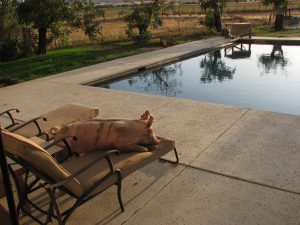If you are a fan of pigs, you will be happy to know that, after an in depth disease prevention program review by USDA veterinarians and other scientists in 2017, California has once again been classified as Pseudorabies “free.”
While Pseudorabies only impacts the health of swine, it is highly transmissible and can be fatal to pigs. Maintaining “free” status is a credit to CDFA and particularly to California’s swine producers, because wild pigs in California can carry and spread the disease to our domestic hogs. Continued vigilance in monitoring for any signs of renewed infection via maintenance of programs standards was particularly appreciated by the review team.
Pseudorabies is a viral disease in swine that is endemic in most parts of the world. It is also known as Aujeszky’s disease and is considered to be one of the most economically important viral diseases of swine. Pseudorabies means “false rabies,” or “ rabies-like;” however, Pseudorabies is related to the herpes virus, not the rabies virus. It does not infect humans.
The Pseudorabies Eradication Program began in 1989 and California initially became Stage-V “free” of the program in February 2001.
Pseudorabies still exists in feral swine. Sporadic cases are occasionally identified in swine herds with exposure to feral swine. Targeted surveillance is utilized for pseudorabies because it increases the odds of rapidly finding disease and helps protect and ensure the commercial swine industry is disease free.
To support this goal, samples are collected from diagnostic laboratories, domestic swine premises with increased risk of exposure to feral swine, livestock markets and buying stations, and various slaughter establishments including sow-boar and market swine.
For more information:
Pseudorabies CDFA Fact Sheet
Pseudorabies Virus Swine Health Information Center
USDA Swine Disease Information
State Status Map



